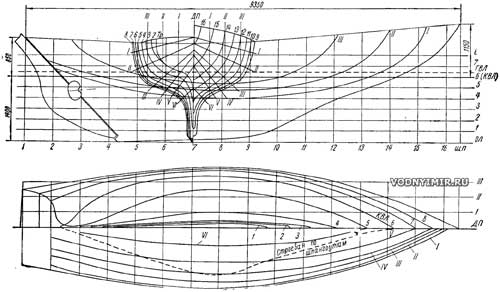The project of a marine cruising yacht made of glass cement
Marine cruising yacht «Novelty» made of glass cement
On June 2, 1963, the naval cruising yacht «Novelty» was launched in Kiev, which is the world's first marine sports vessel made of a new shipbuilding material — glass cement. The yacht was built according to the project and with the direct participation of the authors.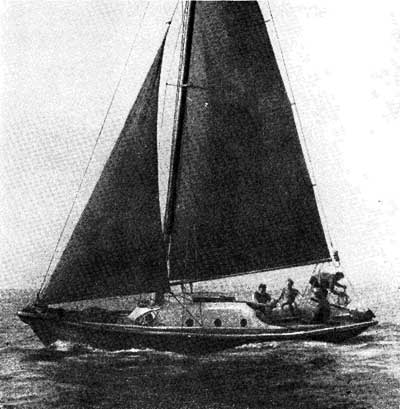
| The main characteristics of the yacht «Novelty» | |
|---|---|
| Longest length, m | 9,35 |
| Kvl length, m | 7,20 |
| Maximum width, m | 2,70 |
| Draft, m | 1,40 |
| Windage, m² | 35 |
| Engine power «SM-557L», hp | 13,5 |
| Displacement, t | 4,5 |
Side view, plan and view from the bow of the yacht «Novelty»
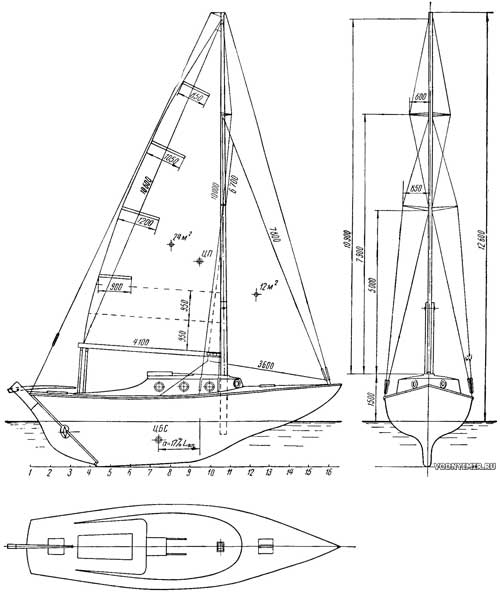
zoom in (opens in a new window)
The yacht's armament is a Bermuda sloop. The contours of the «Novelty» are similar to the contours of yachts of the «Folkbot» type, but it differs from them in somewhat larger sizes, which allows significantly improving the conditions of habitability.
Theoretical drawing of a yacht made of glass cement
The hull of the yacht is divided into four compartments — the forepeak, cabin, engine room and afterpeak, insulated with waterproof glass-cement bulkheads. The yacht is able to maintain buoyancy when filling any one compartment with water.
Drawings of the general location of the yacht made of glass cement
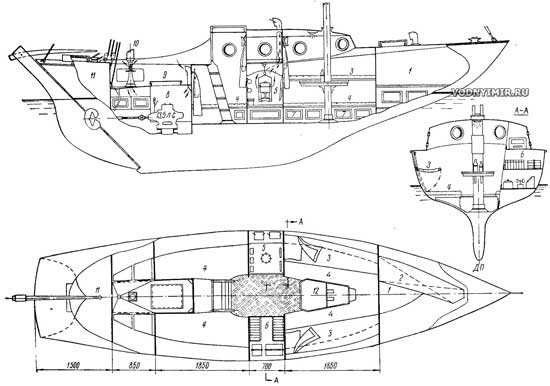
zoom in
1 — forepeak; 2 — spare bunk; 3 — suspended bunk; 4 — stationary bunk; 5 — galley; 6 — shelf for books and maps; 7 — boxes for provisions; 8 — engine room; 9 — cockpit; 10 — compass; 11 — the afterpick; 12 — folding table.
The forepeak is designed for storing sails, cables, anchor ropes and lighting lanterns. There is also one spare bed. The entrance to the forepeak is through the deck hatch.
In the second, largest compartment there is a cabin with a height from the floor to the ceiling of 187 cm. In the cabin there are four stationary and two suspended bunks, a table, a galley, a radio, a cupboard for provisions and dishes, shelves for books and maps. Hangers for shore clothes are fixed on half-berths near each bunk. Storm and work clothes are stored on hangers below deck, in the aft part of the cabin, behind the entrance ramp. The entrance to the cabin is through a sliding hatch.
In the third, engine compartment under the cockpit, the engine and toolboxes are installed.
The fourth compartment — the afterpick is used for storing fuel, paint and lubricants. The entrance to the afterpeak is through the deck hatch.
Yacht construction technology from glass cement
The yacht is built of KB-1 glass cement. The design of the «Novelty» is prefabricated and monolithic. The yacht consists of 13 prefabricated blocks: hull-shell; bow deck section; superstructure; middle deck section in the cockpit area; aft deck section; fore-peak bulkhead; four cabin half-bulkheads; bulkhead separating the cabin from the engine room; after-peak bulkhead and cockpit.
Structural drawing of the yacht
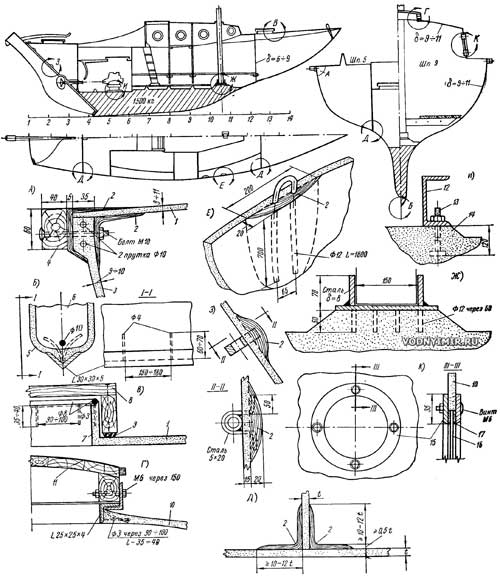
zoom in
1 — deck; 2 — gluing layers of glass cement; 3 — side; 4 — wooden collar; 5 — glass-cement lining; 6 — concrete ballast; 7 — glass-cement manhole coaming; 8 — wooden manhole cover; 9 — rubber gasket; 10 — superstructure; 11 — wooden sliding hatch; 12 — channel beam of the engine foundation; 13 — anchor bolt; 14 — glass cement cushion under the engine foundation; 15 — metal framing of the portholes; 16 — glass; 17 — glass cement check.
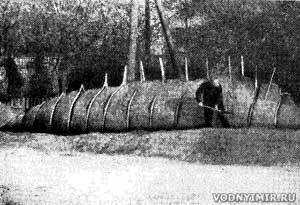 Production of the earthen shape of the yacht hull. |
The first was the main block — a glass-cement casing-shell. This work was divided into two stages. The first preparatory stage is the production of an earthen mold. According to the plazov drawing, plywood patterns were cut out, which were then placed keel up on the construction site — directly on the bank of the Dnieper. The gaps between the patterns were covered with earth containing about 30% of chernozem. Such land, with little moisture, is easy to mold. To give the earthen shape a smooth surface, it was treated with steel trowels during final finishing with simultaneous moistening of each treated area. As a result, the shape acquired a perfectly regular outline with an immaculately smooth surface.
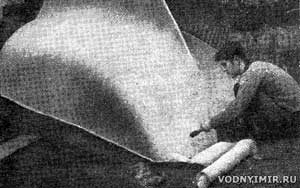 Laying fiberglass and applying cement glue to it. |
Immediately after finishing the earthen mold (in order to avoid its destruction by atmospheric influences), the second stage of work began — the manufacture of the glass-cement hull of the yacht on the mold. First, one layer of fiberglass was laid on the earthen mold, on which cement glue was applied with brushes (water : cement = 0.65). Then 11 layers of glass cement based on alkali-free glass fiber in the form of sections with a diameter of 10-12 microns with a fiber length of 600-700 mm were laid alternately on fiberglass. Fiberglass, which is part of the glass-cement shell and is its first layer, simultaneously served as a separating layer that prevented the shell from sticking to the earthen form.
Laying of each layer of fibers was carried out along and across the body, after which cement glue was applied with hair brushes (water : cement = 0.5). Cement glue (alumina cement grade 400) was prepared in a manual stirrer. The application of cement glue was carried out by the method of facing, i.e. by frequent impact movements from top to bottom, in which the end of the brush, applying cement glue to the fiber, simultaneously seals the glass cement. The fiberglass was laid out in such a way that the cement glue easily penetrated between the fibers. The total thickness of one layer of fibers coated with cement glue was 0.7-0.9 mm, and the fibers protruded through the cement in relief. Excessive thickness of the cement layer is unacceptable, as this reduces the strength of the glass cement.
During the entire manufacturing process of the glass-cement yacht, strict accounting of the consumption of glass fiber and cement was carried out. Only with a certain ratio of these materials it is possible to achieve high strength of glass cement under compression, tension or bending.
The tensile strength of glass cement continuously increases as the amount of glass fiber in it increases, but at the same time its compressive strength decreases. The strength of glass cement during bending (when using cement grade 400-500) increases only with an increase in the content of glass fiber in it — up to 10-15% (a higher content leads to a decrease in strength). Considering that the most characteristic type of stresses in the hull of the yacht are bending stresses, the glass fiber content in the glass cement was assumed to be equal to 10-12% by weight. In some areas of the hull, where large tensile forces may occur, the content of glass fiber increased (edges of the sides; attachment points of the shrouds, rudder). Here, glass cement was made from bundles of fibers soaked in cement glue and well impregnated with cement.
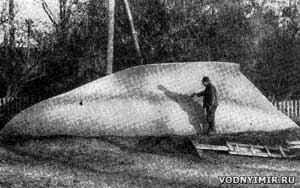 Ready-made glass-cement housing on an earthen mold. |
After laying all the layers of glass cement, the thickness of the shell on the sides and bottom was 9-11 mm. To increase the strength and rigidity of the shell, it was additionally reinforced in three places — along the keel and edges of the sides — with steel rods Ø10 mm. The connection of the steel rods with the body was ensured by gluing them with several layers of glass cement.
The stem and keel are protected from abrasion and impact by a 30x30x5 steel square. The fixing of the square is carried out by means of anchor rods welded to it through 150-180 mm of wire Ø4, 60-70 mm long.
About 200 man-hours were spent on the production of the glass-cement shell. In other words, four people completed the job in five days. The laying of layers at the beginning of each working day was carried out after preliminary wetting of the already hardened glass cement with water or very liquid cement glue. In order to maintain the normal cement hardening regime, the manufactured housing was systematically watered abundantly with water throughout the following week.
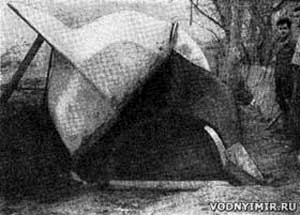 Removing the body from the earthen mold. |
The hull-shell was made in October 1962 and throughout the winter was on an earthen form, since further work on the construction of the yacht was resumed only in the spring. In March, the case was removed from the mold and installed in the keel block.
It is important to note that the removal from the mold and the edging of the glass-cement shell, which has a thickness of only 1 cm with a length of 93 and a width of 2.7 m, was carried out without taking any measures to ensure the uniformity of the distribution of forces. The hull was removed from the mold manually: it was tipped from the up position with the keel on board, and then put into the keel block with the keel down. In the process of such overturning, the hull was in a position where it rested on the ground with only one edge of the side near the middle, but despite the very unfavorable conditions of the hull load, there were no cracks or noticeable deformations. This first «test» demonstrated the high strength and rigidity of the glass-cement hull of the yacht.
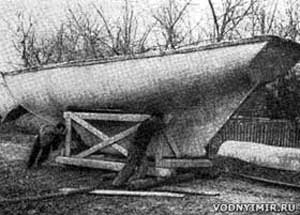 The hull of the yacht on keel blocks. |
The deck and superstructure were made of four glass-cement sections, also molded on an earthen mold. The thickness of the deck and superstructure is 9-11 mm. The coamings of the forepeak and afterpeak hatches are framed with a steel rod Ø8 mm, to which, for fastening with glass cement, anchor tendrils made of wire Ø3 mm are welded through 90-100 mm, having a length of 35-40 mm. The doorway and the coaming of the sliding hatch of the superstructure are framed by a 25x25x4 steel square, which is also connected to the glass cement with wire tendrils welded to it. The specified metal frames of the cutouts were installed in the appropriate places, and as the deck was manufactured, the wire tendrils were sealed with layers of glass cement. As the experience of yacht operation has shown, such metal-glass cement connections are quite strong.
The layout of the yacht hull into sections
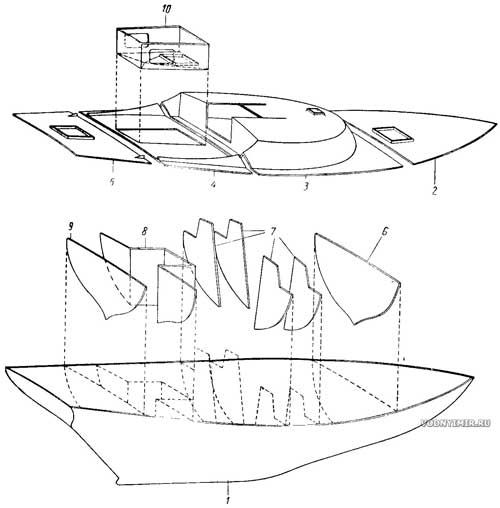
zoom in
1 — hull-shell; 2 — forward deck section; 3 — superstructure with deck; 4 — middle deck section; 5 — aft deck section; 6 — forepeak bulkhead; 7 — semi-bulkheads; 8 — engine room bulkhead; 9 — afterpeak bulkhead; 10 — cockpit.
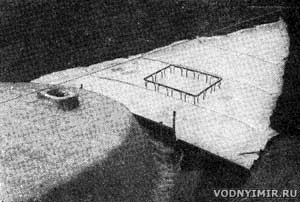 Forming of glass-cement superstructure and deck. The front part of the superstructure with a roof frame is visible on the left, and the bow deck is visible on the right (the first layer of fiberglass is laid on the earthen shape of the deck and a metal frame of the coaming of the forelock is installed). |
Bulkheads and semi-bulkheads were made on wooden boards in a horizontal position. Each molded section, still in its raw state, was cut according to a template, after which it acquired contours corresponding to the place of its installation in the housing. All bulkheads are flat (6-9 mm thick), with the exception of one located between the cabin and the engine compartment; this bulkhead consists of five separately made flat glass cement sheets, then glued together with several layers of glass cement.
After the manufacture of deck sections, superstructures and bulkheads, they began to be installed on the hull of the yacht. The connection of all sections is carried out by gluing. The joints were intensively moistened, then glue was applied with a brush and several layers of glass cement were laid sequentially with fibers across the seam. The approach of the fibers on both sides of the seam was at least 10-12 thicknesses of the connected elements. The total thickness of the glass cement layers at the joint must be at least the thickness of the elements to be joined. The yacht's operation has shown that all its adhesive joints are highly durable and absolutely waterproof.
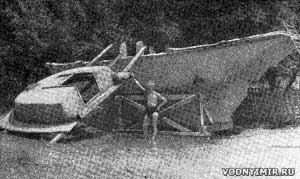 The superstructure is ready for installation on the hull of the yacht. |
Six glass-cement flores are also connected to the housing by gluing.
At the next stage of the work, the fastening of all metal parts was carried out: three shrouds, four shrouds, mast steps, steering loops, engine foundation and deadwood pipe. The shrouds and shrouds are made of steel rods Ø12 mm, curved in the form of the letter P. The shrouds were applied to the inside of the skin, and then glued with 15 layers of glass cement. The sealing depth of the main shrouds is 700 mm (from the deck to the bottom of the shrouds).
As you know, when sailing in the shrouds of a keel yacht, very large loads arise, which reach values close to the displacement of the yacht and are completely transferred to the shrouds. The successful operation of the «Novelty» confirmed the complete reliability of the sealing of the putens. The accumulated experience of working with glass cement has shown that this material has the property of holding metal parts embedded in it exceptionally firmly. Even with a small sealing length equal to 10-12 diameters of the rods, they are so firmly held in the glass cement that the rod itself breaks under excessive load, but its sealed end remains in the glass cement.
The mast step is welded from sheet steel with a thickness of 8 mm and is a rectangular cup. Steel spikes with a diameter of 12 and a length of 60 mm are welded to the bottom of the step. The purpose of these spikes is to eliminate the step shift. The steps were installed on a freshly prepared thickening of glass cement, into which the spikes were placed. Steering loops are fixed in the stern and on the transom of the yacht. Holes were punched in the places where the hinges were installed, into which the anchor whiskers of the hinges were then inserted, sealed from the inside with layers of glass cement.
The steering wheel pen is made of steel sheet with a thickness of 6 mm. To give it a streamlined shape and greater rigidity, the rudder pen below the waterline is also covered with glass cement on both sides. The glass cement glued to the pen still retains a high adhesion to the steel sheet.
The engine foundation is a steel frame made of channels, fixed in the hull of the yacht with four anchor bolts Ø12 mm. Anchor bolts are reinforced with glass cement to a height of 120 mm in a special thickening above the keel. The deadwood pipe is steel with a diameter of 2 inches and a length of 500 mm. Prior to the installation of the pipe, a semicircular window was made in the stern of the yacht to accommodate the screw. The deadwood pipe at a length of 350 mm is covered with glass cement, which firmly connected it to the hull of the yacht.
There are 8 portholes installed in the coamings of the superstructure of the yacht, two of which are made opening. The holes for the portholes were cut in the finished superstructure using a chisel and a metal hacksaw. The cleats for mooring ends and sheets are made of oak and attached to the deck with steel bolts Ø10 mm.
1500 kg of concrete ballast with the addition of scrap metal was laid in the hollow keel of the yacht (1300 kg of ballast was laid before launching the yacht and 200 kg — during the trim of the yacht afloat).
Outside and inside the yacht is painted with oil paint. Oil paints fit very well on glass cement and stay on it for a long time. Recall that the painting of glass-cement vessels has only a decorative value, since glass cement practically does not need protection from the effects of water or the atmosphere.
The weight of the hull of a glass-cement yacht (without ballast), calculated according to the actual consumption of materials, is 1800 kg, i.e. approximately equal to the weight of the hull of a wooden cruising yacht of similar dimensions.
The construction of the glass-cement yacht was carried out in 58 working days in the complete absence of mechanization. An average of three people worked daily. Such a small labor intensity testifies to the exceptional simplicity of the construction of glass-cement vessels.
Boat projects for self-construction
Share this page in the social. networks or bookmark:

